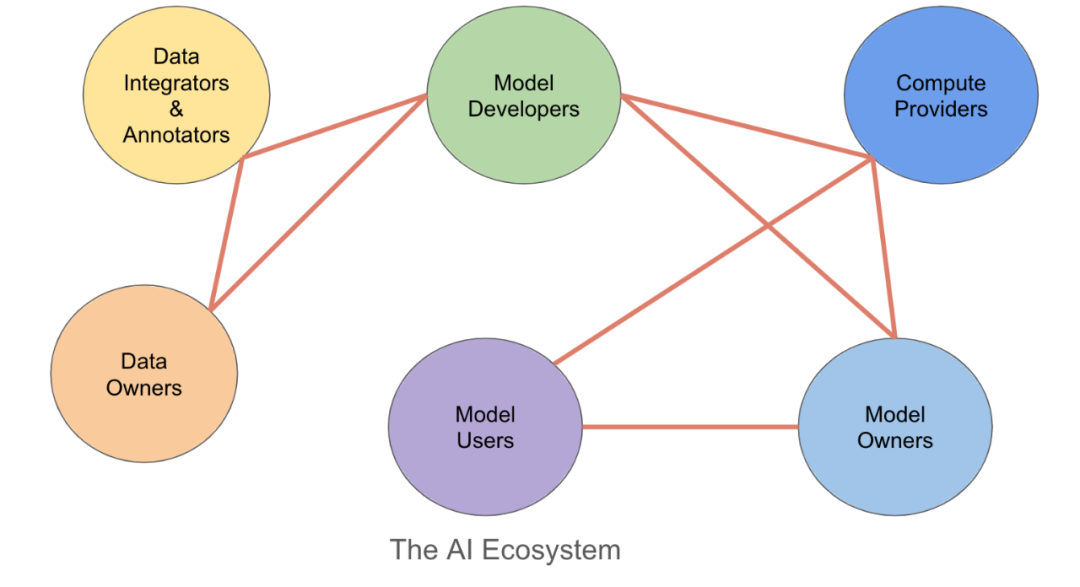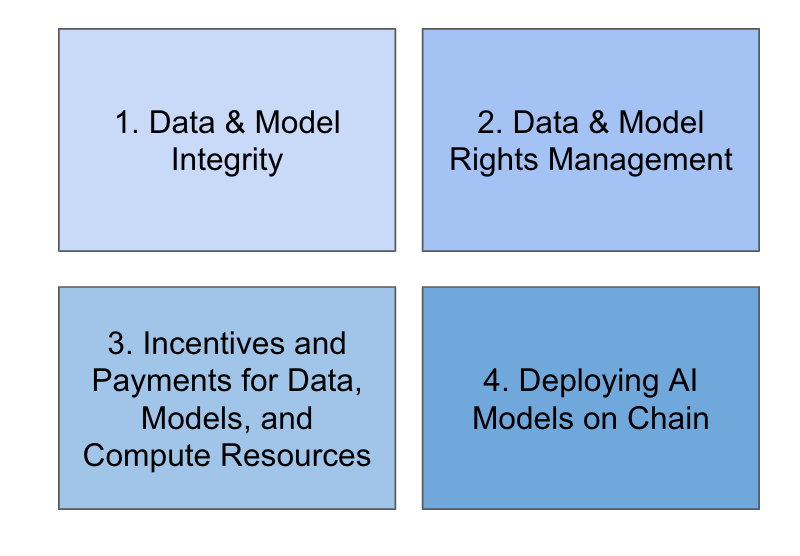Original title: Blockchain for AI
Published on: March 8, 2024
This article explores the potential combination of blockchain and artificial intelligence ecosystems, highlighting some opportunities and applications case. As a company leading the development of blockchain digital assets and decentralized platforms, Coinbase actively seeks cooperation opportunities with the field of artificial intelligence to jointly explore new development prospects. By combining blockchain technology and artificial intelligence, more innovation and growth opportunities can be brought to the digital asset market. This cross-border cooperation is expected to bring more development opportunities and prospects to both fields.

Over the past year, we have witnessed an explosion in the capabilities and applications of artificial intelligence. This includes significant improvements in the sophistication of text-to-image models, large language models, and their use in many business use cases such as search and recommendations, facilitating software development, and big data analytics. It is predicted that generative AI alone will form a $1.3 trillion market by 2032, with a compound annual growth rate (CAGR) of 42% over the next decade.
When looking at the interaction of blockchain and artificial intelligence, there are two key aspects to consider. The first is the use of artificial intelligence/machine learning models and methods to enhance blockchain platforms, decentralized applications, and the trading of digital assets. Second, focus on leveraging blockchain technology to provide value to developers and users of artificial intelligence/machine learning products and services.
Blockchain technology has many basic capabilities that can be used to support the development, deployment, and operation of artificial intelligence models. These capabilities include cryptographic algorithms, blockchain protocols, and smart contracts. These basic properties are closely related to various applications of artificial intelligence, and we will explore them in detail in the following content.
Data security plays a key role in the field of AI. By using decentralized servers that are not vulnerable to attacks, it ensures that data storage cannot be tampered with and is immutable, while improving the high performance of the system. Availability.
Data accountability, traceability and auditability are achieved by recording transactions and assets in an immutable and transparent manner. This approach makes it easier to track the origin, ownership, provenance of data, and agreements with digital signatures and timestamps. This transparency provides the ability to audit and verify data.
Decentralized decision-making: enabling decisions to be made by multiple entities or directly between two parties without a pre-existing trust relationship between them or with a central entity Make decisions.
Autonomous and transparent code execution: Enable programs to execute as smart contracts that are transparent to all parties involved and do not require reliance on trusted and centralized intermediaries It can run autonomously.
Decentralized Identity: Provides a secure digital identity mechanism that allows users to interact with services without revealing their privacy.
Micro payment: Provide a safe and convenient payment method to reduce friction in the payment process.

As shown in the figure above, the AI ecosystem has diverse interests Stakeholders, who interact with each other in terms of data, models, and computing infrastructure. Due to administrative regions and economic boundaries, there is a certain separation between these possible stakeholders. Therefore, the trust issues and payment issues faced in these interactions need to be solved, and blockchain can help solve this problem. Two questions.
We can divide the potential advantageous effects of blockchain on artificial intelligence and the corresponding products and services that can be developed into four major categories, as shown in the figure below. Below, we discuss each of these categories.

Blockchain can be used to develop solutions that help users and developers ensure that data and models are not modified without their knowledge. For example, API-based services can allow data owners and AI developers to record timestamp hashes of datasets and models to ensure their integrity, and record the entire process of model development and used datasets to track the entire process. life cycle, this approach allows for third-party audits or calls from regulators. The system can even be integrated directly into ML development tools such as Pytorch. This can help improve model integrity and trustworthiness by making the model development process more transparent and secure. It may also be possible to record relevant proof of “obsolete” specific data on the blockchain to prove to regulators that a certain provider’s data has been removed from a given model. Recording hashes of on-chain data and model outputs can also help combat deepfakes. For example, an application might be able to ensure the authenticity of the data used by checking digital signatures associated with on-chain data sources, or a decentralized version of “Snopes.com” could be designed and implemented on the blockchain to flag deepfakes.
Non-fungible tokens (NFTs) can prove someone’s ownership of any given digital content or data. Depending on the use case, this could be a model input, such as a prompt to a generative AI tool, the data used to train the model, the model's parameters, or the model's output. NFTs will allow users or developers to maintain their ownership rights and further transfer ownership of the corresponding digital assets to others. It is also possible to envision a blockchain-based data and model access control mechanism, such as smart contracts that allow/restrict access based on a given list of user addresses. Alternatively, it could be integrated with a decentralized identity solution (perhaps using state-of-the-art cryptography such as zero-knowledge proofs) to allow access based on certain proven properties (e.g. allowing access based on proof that the user is old enough or only accessible from certain geographic locations) while protecting user privacy.
Blockchains can use stablecoins to facilitate low-rate micropayments using generative AI models. Smart contracts can allow revenue to be shared among multiple co-owners of a model in a decentralized manner. This co-ownership model is actually a “decentralized Hugging Face” that may allow small and medium-sized model developers to join forces and compete with the larger companies in the field. It can also be used to incentivize data providers, data annotators, model developers or human feedback providers around the world to join a new decentralized project to develop new generative AI models or solutions, and at the same time, have appropriate Mechanism to track contributions so that incentives can be distributed equitably. Blockchain can also be used to create a decentralized data/model/computation marketplace that enables calculation providers, training data providers, model developers, and users to easily search and match each other, provide incentives, make payments, and enter into contracts and protocol. A decentralized blockchain-based review system implemented using smart contracts can incorporate automated and human-based reviewers into the same system to incentivize high-throughput, thorough, high-quality review of data and models.
This category involves running certain AI models directly on the blockchain for greater transparency and trust. AI models may provide some inference or generation use cases directly to end users, giving them confidence that only the model they intend to provide input to can receive said input and produce the output they see without any manipulation, falsification or censorship. Alternatively, AI models can be deployed to help smart contracts adjust and optimize their own parameters in response to user transactions. The AI model may also be a smart contract that uses historical and current transaction data on the chain to make buy/sell/trade decisions on digital assets for profit. These models can be deployed on Layer1 chains as smart contracts or through Layer2 systems such as zk-rollups. These models may be privately owned or decentralized in the form of a DAO, allowing multiple individuals and entities to own a “stake” in a given on-chain model. In the longer term, for such applications, there may be interest in researching and developing an entirely new platform to support AI workflows, given the high data and computational requirements of AI applications.
Coinbase’s mission is to empower more than 1 billion people with economic freedom. As Crypto usage grows, we are focused on building the most trustworthy, compliant products and services and supporting other builders. It’s clear that AI blockchain fits the strategy of enabling those individuals and organizations that are part of the emerging AI ecosystem (which is currently almost entirely based on the centralized and less transparent Web2 framework) to benefit from blockchain and AI-based Benefiting from chain-based Crypto solutions, this is broadly defined.
We believe Coinbase is particularly well-suited to become a major contributor to this space because, a) it has significant visibility and brand power among both retail clients and institutional users of those blockchain assets and services; b) it has a proven track record of success in helping bridge the gap between the emerging Web3 world and existing Web2 systems; c) it has a team with a deep understanding of the growing generative AI ecosystem and the needs of developers and other stakeholders And a strong ML development team.
Coinbase is deeply interested in exploring partnerships and integrations with like-minded companies, such as those with expertise in artificial intelligence solutions and ecosystem services, and are committed to turning ideas into reality.
We would like to thank Dr. Bhaskar Krishnamachari of the University of Southern California for his contribution to this article. Dr. Krishnamachari is a paid consultant to Coinbase and assisted in writing this article in that capacity.
Coinbase Institute White Paper: Blockchain and Artificial Intelligence (AI): Complementary Technologies that Can Improve Each Other, Fall 2023.
David Duong, “The Intersection of Artificial Intelligence and Crypto: What Common Problems in Generative AI Can Blockchain Technology Solve?” ”, Coinbase Research, May 2023.
Application cases of artificial intelligence in blockchain, Chainlink Blog, May 2023.
Steve Vassallo, "AI x Blockchain: Towards the Next Level," Forbes Digital Assets, June 2023.
Salah et al., "Blockchain for Artificial Intelligence: Review and Challenges," IEEE Access, 2019.
Tian et al., Blockchain to AI: A Disruptive Integration, IEEE CSCWD 2022.
Karger et al., "Artificial Intelligence Data Blockchain, Current Status and Open Research", ICIS , 2021.
The above is the detailed content of Coinbase: Investment and Entrepreneurship Opportunities in AI+Blockchain. For more information, please follow other related articles on the PHP Chinese website!




